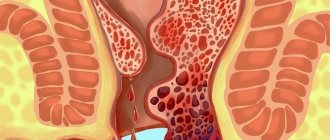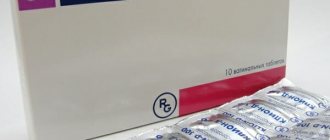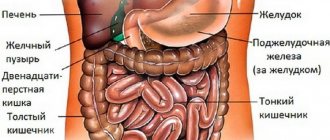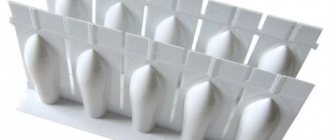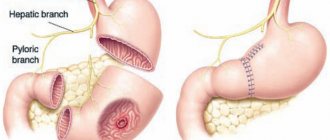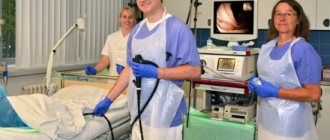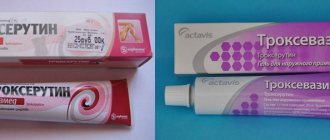The main cause of hemorrhoids is considered to be a violation of the inflow and outflow of blood in the veins and vessels. The pathology is characterized by deformation of the vascular wall, which leads to bleeding and prolapse of hemorrhoids.
Among the radical methods of treating proctological disease, there are many universal operations. A separate operation can be distinguished called disarterization of hemorrhoids. It prevents the movement of blood into the hemorrhoidal plexuses.
Reviews from patients indicate that this method allows you to get rid of unpleasant symptoms in the shortest possible time.
| Features of the surgical method | |
| The essence of the method | Elimination of the vascular factor in the development of hemorrhoids. Transanal disarterization of the distal branches of hemorrhoidal arteries under ultrasound control affects the causes of the development of the disease. Eliminates excess blood flow to the inflamed hemorrhoid. |
| Deadlines | It is performed on an outpatient basis or in a hospital in 1 day. |
| Advantage | Doppler-controlled disarterization of internal hemorrhoids is effective, safe and low-traumatic. Fast rehabilitation and recovery, no serious complications. |
| After operation | All patients are recommended to take bulk-forming medications 2 times a day to prevent constipation. |
| Performing with mucopexy | Allows you to eliminate the flow of arterial blood to hemorrhoids and clearly fix them in the anal canal above the dentate line, even in patients with an advanced form of the disease (stages 3 and 4). |
The essence of the procedure
Desarterization is a minimally invasive operation to remove hemorrhoids, performed using special equipment, the essence of which is to ligate the arteries that supply the venous sinus of the hemorrhoid. During disarterization, the nutrition of hemorrhoids is completely blocked, inflammation subsides, the size of the formation decreases, disappearing without a trace over time.
Elimination of hemorrhoids is performed once, no repetition is required. The risk of complications is minimal.
The author of the hemorrhoid disarterization technique is the Japanese surgeon Kazumasa Morinaga, who developed the operation in 1995. Since 2003, the method of treating hemorrhoids has been used in Russia; in 2005 it was supplemented by the method of tightening prolapsed nodes (RAR).
How does disarterization differ from other surgical methods?
During other surgical operations during which hemorrhoids are removed, the patient usually experiences: severe pain, high trauma, and a long rehabilitation period. Wounds after such surgery are very painful and take a long time to heal. The patient has to stay in hospital for a long time. Then he is discharged, but further recovery at home should take at least 1.5–2 months. All this time, the risk of any complications increases. In a patient, the wound may fester, an abscess may form, and sphincter muscle insufficiency may occur.
When compared with such gentle methods as cryodestruction, scleropia, desarterization still has the greatest advantage. Minimally invasive methods are unable to eliminate the etiology of the disease, and the reason lies in the overflow of hemorrhoidal cones and nodes with blood. This is why relapses may occur after surgery. Typically, with such techniques, nodes are removed one at a time, which requires repeated procedures.
During the operation, the main cause of hemorrhoids is eliminated using the disarterization method - the cessation of nutrition and blood supply to the nodes and cones. This technique completely eradicates the disease, which will never return. In addition, the procedure is performed in one go. If the outcome is favorable, re-intervention is not required.
Kinds
Desarterization of hemorrhoids has two options:
- transanal - HAL (Hemorrhoidal Artery Ligation), the meaning of which is the standard suturing of the arteries supplying hemorrhoids through a special device;
- mucopexy - RAR (Recto Anal Repair), an improved technique, a kind of proctoplasty - tightening of a prolapsed hemorrhoid with fixation to the intestinal wall.
Plastic surgery of internal hemorrhoids is often combined with suturing of the feeding arteries (HAL + RAR), and this is practiced in the later stages of the pathology. An anoscope with ultrasound and illumination is used, which allows you to visualize all the blood vessels supplying the hemorrhoidal node: when a node is detected, the device gives a sound signal. The proctologist identifies the stem of each node and:
- ligates it;
- stitches the rectum to the mucosa;
- pulls in;
- fixes.
After a while, the node disappears with the formation of a connective tissue scar.
Operating principle
For ligation of hemorrhoidal
arteries, anoscopes are used - special devices with built-in ultrasonic sensors with sound transducers.
The device recognizes hemorrhoidal arteries and transforms the pulsation into sound signals. The coloproctologist receives a signal and accurately identifies all hemorrhoidal
arteries in the lower rectum.
Through the anoscope window, the vessels are sutured and ligated. The disarterization method
is used to treat any stage of the disease, including in the early stages.
After surgery for hemorrhoids
the nodes stop receiving arterial blood, which causes their desolation and reduction in size. The patient stops feeling pain and bleeding stops. In the “Doctor Nearby” network of clinics, the operation is also complemented by lifting, when hemorrhoids are tightened and fixed to the walls of the rectum.
Gradually, the expanded nodes collapse and are replaced by connective tissue. Treatment of hemorrhoids
This technology is considered one of the most gentle, safe, painless
methods
. Today, such therapy for hemorrhoids is considered the gold standard. After just a few days, the patient can return to their usual rhythm of life.
Indications
Desarterization of hemorrhoids is indicated at any stage of hemorrhoids, in any form, the only absolute limitation is to perform the operation during a period of remission. The optimal method is for stage 2-3 hemorrhoids.
The direct reason for prescribing the technique is:
- thrombosis of the hemorrhoid;
- lack of results from conservative therapy;
- relapse after minimally invasive surgery.
Contraindications
Operation
HAL-RAR
method is not performed in the presence of acute proctological processes. Patients diagnosed with proctitis (inflammation of the rectal mucosa) or thrombosis of external hemorrhoids must first stop acute pathological processes.
At the clinical diagnostic center on Simonovsky Val, coloproctologist surgeons perform several procedures simultaneously. In the presence of acute thrombosis of external hemorrhoids, the patient first has the thrombus removed from the external plexuses, and then the internal vessels are constricted.
Preparation
Disarterization does not require any special preparation. Before the intervention, a clinical minimum examination is prescribed:
- UAC, OAM, biochemistry;
- blood for HIV, RW, hepatitis
- blood type, PTI (prothrombin index);
- FLG or plain chest x-ray;
- ECG;
- physician's report on health status.
A week before the operation, in consultation with the doctor, stop taking anticoagulants or disaggregants (Cardiomagnyl, Curantil, Fraxiparine), the day before the intervention they switch to a slag-free diet (exclude baked goods, rice, all flour) to prevent gas formation and the formation of coarse feces.
A cleansing enema is given the night before and on the day of surgery, or laxatives (Fortrans) are used according to a special regimen: 2 liters in the evening before disarterization, 2 liters in the morning. For example, if the operation is scheduled for 10 am, the drug is taken at 5 am. Stool appears after 1.5 hours and complete bowel movement occurs within 2-3 hours. I drink the solution after each bowel movement, it can provoke vomiting, so it is customary to eat it with a slice of lemon.
How to properly prepare for surgery?
Before performing the technique, the patient must carefully prepare his body in order to reduce the risk of complications in the postoperative period and recover in a short time. 5-7 days before surgery, the proctologist should refer the patient to specialists to undergo the necessary studies, namely:
- electrocardiogram;
- chest fluorography;
- general clinical analysis of blood and urine;
- blood biochemistry.
In the case of therapy with drugs from the group of non-steroidal anti-inflammatory drugs, it is necessary to stop taking them 7 days before surgery, since they can negatively affect blood clotting factors.
24 hours before surgery, the intestines are cleansed using laxatives that can be taken at home
In the preoperative period, it is also recommended to adhere to a special diet that ensures bowel cleansing and prevents constipation after surgery. Therefore, two days before the procedure, you need to normalize your diet as follows:
- Exclude from the menu products that lead to excessive gas formation and strengthening of stools (rice, baked goods made from white flour, sausage products, canned food, bananas, fatty broths).
- On the eve of the procedure, the patient should eat no later than 18.00, but the portions should be small (baked vegetables, kefir, boiled fish).
- On the day of the procedure, you can have unsweetened tea, kefir, yogurt, and vegetable soup for breakfast.
Progress of the operation
Desarterization of hemorrhoids is an outpatient operation, with anesthesia - epidural or intravenous (premedication). Sometimes, with a combined form of hemorrhoids or advanced stage 4 of the disease, hospitalization in a day hospital for a couple of days is required for observation by a doctor after surgery.
To remove hemorrhoids, an anoscope with an ultrasonic sensor is used, which helps to accurately determine the location of the arteries supplying each node with an audio signal. The location of the nodes is indicated like numbers on a watch dial.
The process of isolating the vessel is performed with a special instrument through the side window of the anoscope: a couple of cm above the anorectal line. The sutures are made with self-absorbing material (vicryl), which does not leave any marks.
All feeding arteries are ligated one by one (a missed vessel is a guarantee of recurrence of hemorrhoids). Up to 11 arteries are ligated during the operation.
Mucopexy or a kind of lifting is additional fastening of the internal hemorrhoid to the intestinal wall with its traction to the discovered artery. The operation is performed as the last stage in the presence of internal hemorrhoids with prolapse of nodes. Such an intervention occurs under Doppler control (ultrasound), the maximum prolapse is sutured with a continuous suture, the ends of the threads are tied, the mucous membrane is pulled in the proximal direction, restoring the lumen of the rectum.
Consequences of disarterization of internal hemorrhoids
After the operation, the patient can return home the same day, but he should follow the recommendations, especially carefully those related to diet. It is not recommended to consume mechanically unprocessed and rough food, as well as spicy food. Alcohol is excluded from the diet. You should drink up to three liters of water in total for all daily meals. For two weeks after the intervention it is prohibited:
- physical activity (running, weight lifting, sex) . Minimum activity should be maintained in the form of moderate exercise to improve circulation in the lower half of the body, leisurely walks are also recommended;
- thermal procedures - sauna, hot bath, steam bath, since strong vasodilation occurs, which can cause bleeding and damage to the wound surface;
- manipulations in the area of surgery - do not give enemas or rectal suppositories. If you experience any discomfort, you should consult your doctor.
The patient must listen to his own well-being and take the recovery period responsibly. He should monitor the condition of the stool - its color, consistency. This is necessary to prevent rectal bleeding. If the stool is hard during the diet, the doctor may prescribe mild laxatives.
If previously it was believed that disarterization was effective only at the 2nd and occasionally 3rd stages of the disease, then thanks to the updated technique, patients with the 3rd and 4th stages can also be treated.
At the end of the period of convalescence and spontaneous rejection of dry hemorrhoids, another examination can be carried out, after which no restrictions regarding lifestyle and activities are imposed.
Rehabilitation
According to patient reviews, successful disarterization of hemorrhoids requires virtually no rehabilitation. Only two to three hours of observation in a clinic or day hospital. In some cases, observation is necessary for 2-3 days. The patient can begin work immediately after discharge.
On the first day after surgery, you should drink as much water as possible (at least 2 liters), and from food - broths and liquid soups. Then, the standard diet for hemorrhoids: exclusion of everything spicy, fatty, salty, canned, fried. Priority – fiber (40% of the diet):
- fruits vegetables;
- cereals;
- seaweed;
- bran;
- flax-seed.
Natural fibers prevent constipation. If you still have problems with bowel movements, laxatives (Guttalax) are needed. Rectal suppositories (Relief), cleansing enemas are prohibited throughout the recovery period.
Alcohol and nicotine, baths, saunas, and swimming pools are prohibited for a month.
The drinking regimen is calculated individually (40 ml of water per kg of weight).
It is mandatory to observe hygiene measures in the intimate area after each bowel movement.
Physical activity - dosed (maximum for lifting - 2 kg), walking short distances and exercises are recommended. Sex will have to be postponed for at least 10 days.
The following medications should not be taken for a month after disarterization of hemorrhoidal vessels:
- NVP (NVPS) - Nurofen, Voltaren, Diclofenac - they provoke bleeding;
- anticoagulants - Cardiomagnyl, Thrombo-ASS, Aspirin - affect blood clotting.
Any symptoms that cause concern require consultation with a doctor; self-medication is prohibited.
Features of the rehabilitation period
After this procedure there are no strict dietary restrictions. In the first days, the patient should limit the consumption of spicy, smoked, salty foods. You must stop drinking any alcoholic beverages.
Prohibited:
- physical activity, sports;
- visiting saunas, baths, taking hot baths;
- sexual intercourse within 10 days;
- enemas.
Desarterization of hemorrhoids, what it is and how to recover after it, will be explained in detail by your attending physician. Care must be taken with the chair so as not to damage the seams.
In the first days after desertion, doctors recommend taking mild laxatives. Severe pain in the anal area can be eliminated by taking NSAIDs.
Possible complications
The disarterization operation is minimally invasive, but very rarely can be complicated:
- pain that is relieved by taking analgesics;
- bleeding (error during surgery, sutures coming apart) - you should call an ambulance;
- hyperthermia – a sign of inflammation; consultation with a doctor is necessary);
- relapse – repeated intervention, the type of which the doctor will choose.
It is extremely rare for hemorrhoids to prolapse. The reason is a spasm of the internal sphincter with swelling of the operated nodes. This is possible during the first two postoperative weeks.
Advantages of the method
The main advantages of the newest method of removing nodes in the rectum:
- Efficiency of treatment and targeted effects.
The cause of the disease is eliminated directly: after ligation of the hemorrhoidal arteries
, they become empty and are no longer filled with blood.
- Restoring the functions of internal organs.
- Normalization of the outflow of venous blood from hemorrhoidal vessels.
- Minimum contraindications to manipulation.
Special techniques allow the operation
in the presence of fistulas, fissures and other pathological processes in the anal area.
- The procedure is quick and painless.
The surgical intervention takes 20–30 minutes, and modern types of anesthesia are used. There are no wounds left in the anal area. Pain after manipulation is minimal.
- Single-use procedure without multi-stage procedure treatment
.
- No long postoperative period.
Desarterization
It takes only one day and takes place in an outpatient clinic. In total, the patient spends no more than 12–18 hours in the clinic.
- Preservation of the usual rhythm of life.
After 1-2 days the person returns to work. He recovers quickly provided he follows all medical recommendations.
- Positive feedback from patients.
Surgery using the HAL-RAR
successfully used all over the world.
Pros and cons of disarterization
All advantages are directly related to the qualifications of the doctor performing the intervention. The main advantage of disarterization is its minimally invasive nature, as well as:
- there is no lengthy preparation;
- no pain after surgery;
- short duration of surgical intervention (no more than half an hour);
- possibility of carrying out at any stage and form of hemorrhoids;
- fistulas, fissures, chronic pathologies of the rectum are not a contraindication;
- The procedure is outpatient and does not require dressings;
- there are no wounds, healing occurs without scars;
- minimal risk of relapse (doctor’s error) – re-formation of the node is impossible;
- rehabilitation – maximum 2-3 days;
- the normal lumen of the rectum is restored (tightening of nodes);
- anesthesia - epidural or intravenous;
- other minimally invasive techniques do not completely eliminate the nutrition of the varicose cavity; only ligation of the arteries solves this problem.
The main disadvantage is the high cost of the service and the complexity of the technique. The risk of relapse due to inaccuracy in the number of ligated nodes is extremely rare.
How the manipulation is performed
Disarterization operation
takes place in the clinic without hospitalization of the patient. Before surgery, the person is put into deep sleep, and anesthetic drugs are injected into a vein or into the spinal canals. A disposable anoscope equipped with an ultrasound sensor is inserted into the rectum. After the coloproctologist surgeon has received a signal that hemorrhoidal arteries have been detected, he stitches them with special instruments with self-absorbing suture material.
hemorrhoidal arteries are stitched and ligated
: large, medium and small.
This is necessary in order to prevent relapse of the disease. During one procedure, the doctor stitches from 3 to 10 or more arteries. The duration of the manipulation depends on how many hemorrhoidal
arteries are identified. On average, the operation lasts 20–30 minutes, and after 6 hours the patient leaves the clinic.
